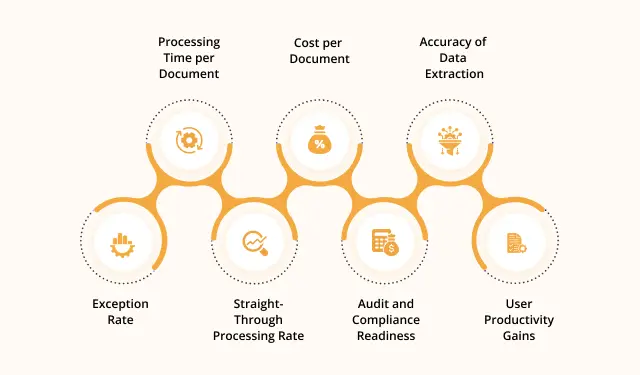Measuring return on investment for automation initiatives is no longer about vague efficiency claims. Finance leaders need hard, measurable data to justify technology adoption and identify where it’s paying off. In the case of AI-powered document processing, ROI is best understood through specific operational and financial metrics that reveal both direct cost savings and indirect performance gains.
Below are seven key metrics that can help determine the true value of adopting intelligent document technology in finance operations.
1. Processing Time per Document
One of the most visible benefits of AI-powered document processing is a sharp reduction in time spent handling each file. Measuring average processing time before and after implementation shows whether automation is delivering faster turnaround on invoices, statements, and other financial documents. For high-volume departments like accounts payable, even a 20–30% reduction can translate into significant annual savings.
2. Cost per Document
This metric evaluates the all-in cost to process a single document, including labor, software licensing, exception handling, and storage. Effective document automation in finance typically drives this number down by reducing manual intervention and the need for repetitive data entry. Tracking it quarterly provides a clear line of sight into cost savings.
3. Accuracy of Data Extraction
Errors in finance document processing can lead to compliance risks, delayed payments, and costly reconciliations. Measuring data extraction accuracy comparing automated outputs with verified records shows whether the system is consistently delivering reliable results. Accuracy rates above 95% are considered strong, but the real value lies in steady improvement over time.
4. Exception Rate
An exception is any document that cannot be processed automatically and requires manual review. High exception rates limit the benefits of automation. Monitoring this metric helps teams identify where templates, classification models, or data recognition rules need refinement. For accounts payable automation, lower exception rates mean invoices move faster through the approval cycle and fewer supplier queries arise.
5. Straight-Through Processing Rate
Straight-through processing (STP) measures the percentage of documents processed without any manual intervention from ingestion to approval or posting. A rising STP rate is a strong indicator of maturing automation capability. In finance departments, high STP rates can speed up payment cycles, reduce backlog, and improve supplier relationships.
6. Audit and Compliance Readiness
For finance teams, audit preparation can be resource-heavy. Automated systems that tag, classify, and store documents in structured formats make it easier to retrieve records for audit purposes. Measuring how long it takes to assemble audit files before and after adopting document automation in finance highlights the compliance advantage especially in regulated industries.
7. User Productivity Gains
Automation doesn’t replace finance staff, it frees them to focus on higher-value tasks such as analysis, vendor negotiation, and cash flow planning. Tracking the percentage of employee time spent on manual document handling versus strategic work can show whether AI-powered document processing is genuinely boosting productivity and morale.
Linking Metrics to Real Business Outcomes
Collecting these metrics is only the first step. For them to drive strategic decisions, finance leaders should connect them to business outcomes like reduced operating expenses, improved cash flow, and stronger compliance standing. For instance:
- Faster processing times can lead to early payment discounts.
- Higher data accuracy reduces the cost of error correction.
- Improved STP rates can shorten monthly close cycles.
Building a Continuous Improvement Loop
The most effective finance teams treat these metrics as part of an ongoing improvement process rather than a one-off ROI calculation. Regularly reviewing results allows organizations to identify bottlenecks, adjust automation workflows, and keep performance trending upward. For example, a quarterly review of finance document processing accuracy rates may reveal that certain document types consistently underperform, prompting model retraining or rule adjustments.
Final Word
In finance, ROI is not just about cost it’s about agility, accuracy, and control. Measuring these seven metrics gives leaders a concrete framework for evaluating whether accounts payable automation and broader document processing initiatives are delivering on their promise. Over time, these insights not only justify the investment but also guide refinements that keep automation aligned with evolving business needs.
Want to know how DocVu.AI works?
Frequently Asked Questions
It helps process invoices, receipts, statements, and other finance documents faster and with higher accuracy.
Yes, it integrates with leading ERP, accounting, and cloud storage platforms for smooth data flow.
Yes, it uses AI to read and process documents even if the format changes or is new.
Yes, onboarding, training, and ongoing support are provided to ensure you get the most from the platform.






